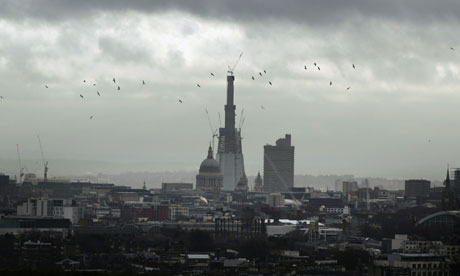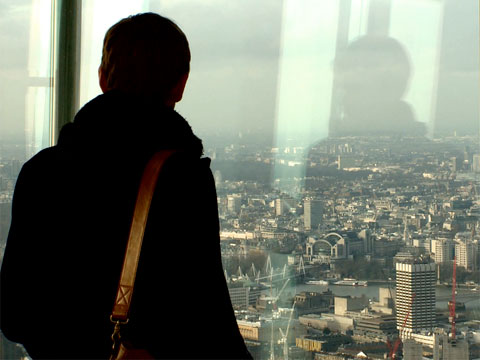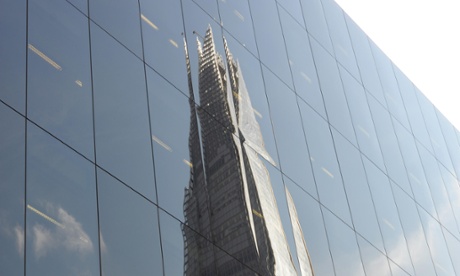It's a punt, a hustle, a gambit, a try-on. It is a trophy of punk urbanism, dressed by a Pritzker-winning architect. It owes its life to a motley band that includes a socialist mayor, Qatari royalty and a developer once treated as a bit of a joke. At one time, it looked like a fantasy or a stunt but, now rising fast next to London Bridge station, the Shard is undeniably there. It is the tallest building in Britain, even in its far-from-finished state. It is fast becoming London's, and the country's, most conspicuous monument.
Its progenitor is Irvine Sellar, who first made his name as a baron of boutiques in the 1960s rag trade, before moving into property and going spectacularly bust in the early 90s. When, in 2000, he revealed the tower that would become the Shard, he was better known for developing business units in Warrington and Portsmouth and he had limited experience of buildings over three storeys. The big, established property companies doubted almost everything about him: his expertise, his backing, even whether his luxuriant hair was really all his own.
His site was a cramped piece of space next to London Bridge station, then occupied by a brownish, 1970s structure, the 24-storey Southwark Towers. The location was a poor relation of the City, just across the Thames, but it was one favoured by the London Plan, drawn up under the then mayor Ken Livingstone. This encouraged tall buildings on sites next to large interchanges, on the grounds that it would concentrate people as close as possible to public transport.
The London Plan also said that tall buildings should be well designed, whatever that might mean. Sellar brought in Renzo Piano, the suave Genovese architect who designed the Pompidou Centre with Richard Rogers, and, more recently, the New York Times Tower. Piano had a reputation for refinement and craftsmanship and an aura of fame. He replaced the project's less glamorous first architects, Broadway Malyan, although they were retained to assist with the project.
Piano declared that his design was inspired by old pictures of church spires and ships' masts on the river. It would, he said, "have a nice light presence". At the bottom it would "melt with the City" and at the top it would "come to almost nothing". "Towers belong to our imagination," he said, "and if a new one can fit with the dream of people it will be a success." He said it would be a "shard of crystal", with angled planes in a special kind of glass, that would catch the changing light.
Unusually, it would not just be a stack of office floors, but a "vertical village", including a hotel, public viewing deck and luxury apartments near the top, with a "radiator" at the very pinnacle which would catch cooling breezes as part of the project's effort to be sustainable. The tower's height was to be 310 metres.
The Shard got planning permission from the London Borough of Southwark, but then had to survive a public inquiry, which examined whether it interfered unacceptably with views of St Paul's Cathedral from Hampstead Heath. It was decided it did not. John Prescott, then the minister in charge of planning, declared that he was "satisfied that the proposed tower is of the highest architectural quality".
Ken Livingstone was also an enthusiastic supporter, keen to set a precedent for the many towers he wanted built in London, and he promised that Transport for London would move its offices there, in a bid to make the project more viable. Even so, it seemed unlikely that such an expensive and complex work could be built, especially when the financial wind changed. Many expected Sellar to sell the site and pocket the profit that came with getting planning permission.
It was saved by the Qataris who, as part of a strategy of acquiring glamorous London developments, bought an 80% stake in 2008. And now it is appearing, with that quality of unarguable but implausible fact that often accompanies skyscrapers. The offices, flats, hotel and viewing gallery will all be there. Its glass currently looks more prosaic than the magical stuff Piano promised and the tower doesn't look quite as light and melting as he suggested, or as shimmery as the computer images showed, although final judgment should be reserved until the whole form is there. The main thing Piano has brought, that firms like Broadway Malyan have not, is single-mindedness, consistency and confidence. This building doesn't dither.
It does indeed dwarf St Paul's when seen from Parliament Hill, especially when captured with a telephoto lens, but whether it is a stab in the heart of London's scenery is debatable. I don't favour the random desecration of views, but this one was already more haphazard and compromised than most. If you peer at the distant dome with the big spike behind it, it's uncomfortable, but not to a degree that should be outlawed. Many of the heath's strollers, snoggers and dogwalkers will not give a second glance to this architectural knifing dimly visible through the haze.
What the Shard does do is change the sense of scale in the whole centre of the City. It's as if a zoom-out button has been pressed, making hefty works like Tate Modern and Tower Bridge look a bit smaller. This is not the first time such a shift has happened: Inigo Jones's Banqueting House, which now looks petite, once dwarfed its neighbours and buildings such as St Pancras station and Harrods led previous jumps in scale. The Shard happens to be the biggest yet. It is a visitation from a hyperverse where different dimensions apply and also different orders of money. In this, the Shard resembles One Hyde Park, another creation of the coalition of Livingstone's politics, Qatari finance and eminent hi-tech architects.
It is a symbol, but of what? Not of an ideal or a heroic event, obviously, but not exactly of the inexorable march of economics, either. It is not a pure expression of land values or of profit-and-loss calculations. It's more eccentric than that, something that popped through a gap in London's wonky, many-layered planning system, where opinion and discussion counts for more than clear rules, and where many years and hundreds of thousands of pounds are spent deliberating arbitrary questions of taste. It is the crystallisation of a series of deals, involving players from Cricklewood, Hull, Southwark, the Gulf and Italy.
If anyone had sat down to plan the most sensible distribution of towers in London, they would not have come up with the Shard, standing alone on a crowded site in a location that is still a bit rackety, with little apparent relation to the things around it. But no one plans London like this and it's unlikely to happen any time soon. Meanwhile, the startling, part-graceful, part-clunky, impressive, slightly nutty Shard is a true monument to the city that made it.











